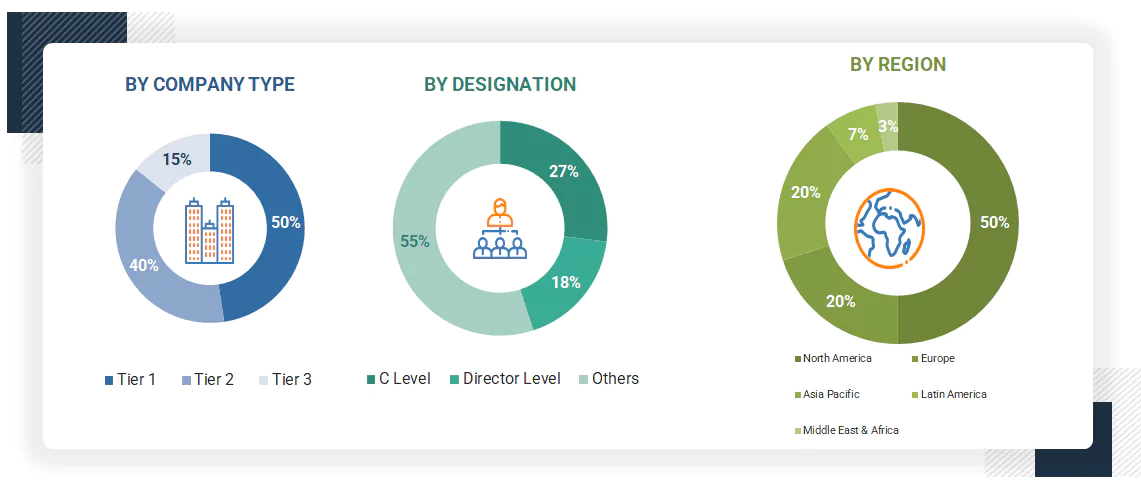The study involved major activities in estimating the current market size for the global lateral flow assays market.
Exhaustive secondary research was done to collect information on the lateral flow assays industry. The next step was to validate these findings, assumptions, and sizing with industry experts across the value chain using primary research. Different approaches, such as top-down and bottom-up, were employed to estimate the total market size. After that, the market breakup and data triangulation procedures were used to estimate the market size of the segments and subsegments of the lateral flow assays market.
The four steps involved in estimating the market size are:
Secondary Research
The secondary research process involves the widespread use of secondary sources, directories, databases, white papers, annual reports, investor presentations, SEC filings of companies and publications from government sources [such as US Food and Drug Administration, World Health Organization (WHO), Centers for Disease Control and Prevention, International Organization for Standardization (ISO), Agency for Healthcare Research and Quality, were referred to identify and collect information for the global lateral flow assays market study. It was also used to obtain important information about the key players and market classification & segmentation according to industry trends, to the bottom-most level, and key developments related to market and technology perspectives. A database of the key industry leaders was also prepared using secondary research.
Primary Research
In the primary research process, various sources from both the supply and demand sides were interviewed to obtain qualitative and quantitative information for this report. The primary sources from the supply side include industry experts such as CEOs, vice presidents, marketing and sales directors, technology & innovation directors, and related key executives from various key companies and organizations in the lateral flow assays market. The primary sources from the demand side include hospitals, clinics, diagnostic laboratories, pharmaceutical and biotechnology companies. Primary research was conducted to validate the market segmentation, identify key players, and gather insights on key industry trends & key market dynamics.
The following is a breakdown of the primary respondents:

Note 1: Other designations include sales managers, marketing managers, and product managers.
Note 2: Companies are classified into tiers based on their total revenues. As of 2024, Tier 1 = >USD 100 million, Tier 2 = USD 10 million to USD 100 million, and Tier 3 = < USD 10 million.
To know about the assumptions considered for the study, download the pdf brochure
Market Size Estimation
For the global market value, annual revenues were calculated based on the revenue mapping of major product manufacturers and OEMs active in the global lateral flow assays market. All the major service providers were identified at the global and/or country/regional level. Revenue mapping for the respective business segments/sub-segments was done for the major players. The global lateral flow assays market was split into various segments and sub-segments based on:
-
List of major players operating in the market at the regional and/or country level
-
Product mapping of lateral flow assay providers at the regional and/or country level
-
Mapping of annual revenue generated by listed major players from lateral flow assays (or the nearest reported business unit/product category)
-
Extrapolation of the revenue mapping of the listed major players to derive the global market value of the respective segments/subsegments
-
Summation of the market value of all segments/subsegments to arrive at the global lateral flow assays market
The above-mentioned data was consolidated and added with detailed inputs and analysis from MarketsandMarkets and presented in this report.
The research methodology used to estimate the market size includes the following:
Data Triangulation
After arriving at the overall market size by applying the process mentioned above, the total market was split into several segments. To complete the overall market engineering process and arrive at the exact statistics for all segments and subsegments, data triangulation and market breakdown procedures were employed, wherever applicable. The data was triangulated by studying various factors and trends from both the demand and supply sides.
Market Definition
Lateral flow assays, or lateral flow immunochromatographic assays, are simple-to-use diagnostic devices to confirm the presence or absence of a target analyte, such as pathogens or biomarkers in humans or animals, or contaminants in water supplies, without requiring specialized equipment.
Stakeholders
-
Lateral flow assay product manufacturers
-
Lateral flow assay vendors and distributors
-
Hospitals
-
Clinical and diagnostic laboratories
-
Pharmaceutical and biotechnological companies
-
Venture capitalists and investors
Report Objectives
-
To define, describe, analyze, and forecast the lateral flow assays (LFA) market by product, application, technique, sample type, end user, and region
-
To provide detailed information regarding the major factors influencing market growth (such as drivers, restraints, opportunities, and challenges)
-
To analyze the micromarkets with respect to individual growth trends, prospects, and contributions to the overall lateral flow assays market
-
To analyze market opportunities for stakeholders and provide details of the competitive landscape for key players
-
To forecast the size of the market segments with respect to five regions: North America, Europe, the Asia Pacific, Latin America, the Middle East & Africa, and GCC Countries.
-
To profile the key players and comprehensively analyze their product portfolios, market positions, and core competencies
-
To benchmark players within the market using the proprietary Company Evaluation Matrix framework, which analyzes market players on various parameters within the broad categories of business and product excellence
-
To study the impact of AI/Gen AI on the market, along with the macroeconomic outlook for each region



User
Nov, 2019
this is good.
Max
Oct, 2022
Which factors plays the vital role the global growth of Lateral Flow Assays Market?.
User
Jun, 2018
this is good.